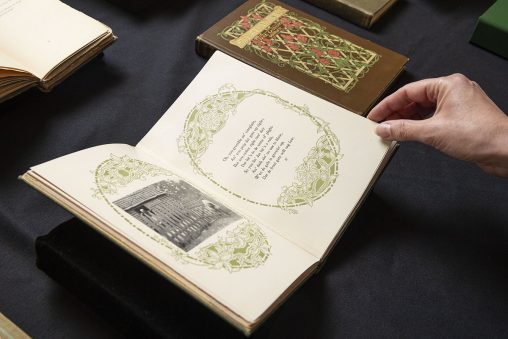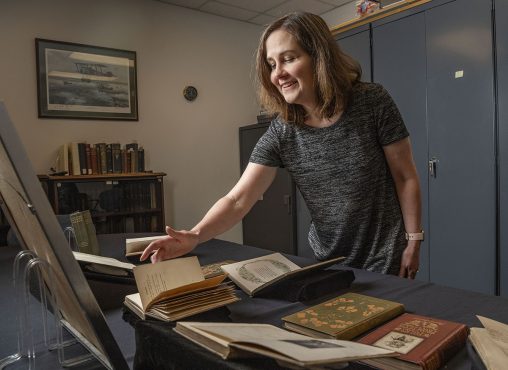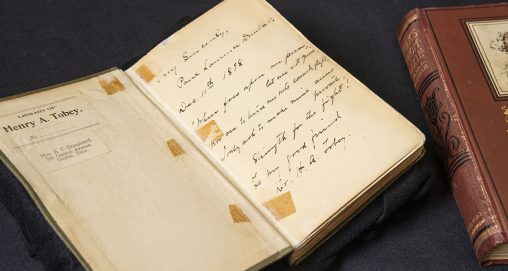
Wright State’s Special Collections and Archives conserved books of poetry and short stories by Paul Laurence Dunbar, allowing scholars and the public to see Dunbar’s inscriptions and the unique photographs and art that accompany the poems in five of the books.
Rare, first-edition books by Paul Laurence Dunbar can now be safely viewed and studied in Wright State University’s Special Collections and Archives after undergoing conservation treatment.
Nine books of poetry and two books of short stories, all inscribed by Dunbar — a prolific writer from Dayton who died at the age of 33 in 1906 — were conserved.
The books are part of the “Paul Laurence Dunbar Collection” in the University Libraries’ Special Collections and Archives. They are often displayed in exhibitions and on tours of the archives and are available for viewing and research in the Special Collections and Archives reading room on the fourth floor of Dunbar Library.
Conserving the books will allow scholars and the public to see Dunbar’s inscriptions, some of which include his handwritten poetry, and the unique photographs and art that accompany the poems in five of the books.
Dunbar’s works are among the most popular items in the archives’ extensive collections, said Toni Vanden Bos, preservation and cataloging archivist at Wright State, who oversaw the project.
“The history of the books provides a direct link back to Dunbar, back to his time,” she said. “When you sit down with the books, you are sitting down with him in a way.”
Born in Dayton in 1872, Dunbar was one of the first influential Black poets in American literature. He was known for his use of dialect poetry and was also an accomplished poet and novelist in standard English. Dunbar published 12 books of poetry, four novels and four books of short stories.
The 11 books that were conserved are rare and had never been repaired or treated. The novels were in overall good condition while the poetry books were distressed, some with detached pages or covers and loose sewing.
Special Collections and Archives commissioned ECS Conservation in Indiana to treat the books. The company improved the books’ structural stability, reattaching detached pages and deacidifying the pages. The archives also had heavy custom hinge boxes made for each of the books to protect them.

Toni Vanden Bos, preservation and cataloging archivist, said Paul Laurence Dunbar’s works are among the most popular items in the extensive collections available in Special Collections and Archives.
The conservation project was supported by a Library Services and Technology Act Conservation grant from the federal Institute of Museum and Library Services, awarded by the State Library of Ohio.
The books were gifted to the University Libraries in 1975 by William Shepard, the grandson of Henry Tobey, a friend and patron of Dunbar who was the superintendent of the Toledo State Hospital.
To thank Tobey for his support, Dunbar would inscribe a book for him. One of Vanden Bos’ favorite inscriptions is from “Li’l’ Gal,” which Dunbar published in 1904:
Dear Dr. Tobey,
This is the seventeenth book. That’s what you get for encouraging youthful ambition and you did. You can’t deny it.
Gratefully yours,
Paul
Five of the poetry books feature photographs that illustrate Dunbar’s poems taken by faculty members in the Camera Club of Hampton Normal and Agricultural Institute, which today is known as Hampton University, in Virginia. The photos depict African American life at the turn of the 20th century, offering another area of study and insight into Dunbar’s choices.
“The photographs are considered a significant cultural resource,” Vanden Bos said, “because at the time there weren’t a lot of photographs of African Americans in daily-life settings.”
Before the books were treated, Special Collections and Archives digitally scanned each page. Digital copies of the books will be posted on Special Collections and Archives’ Paul Laurence Dunbar website, providing researchers a way to view the poems with the illustrations and the personal inscriptions without further damaging the books.
Dunbar was born in Dayton on June 27, 1872, to parents who were enslaved prior to the Civil War. He attended Central High School, where he was the only African American in his class and was a classmate of Orville Wright. Dunbar started publishing his poems in his high school newspaper and in Dayton newspapers.

Many of the books that were conserved feature handwritten inscriptions by Paul Laurence Dunbar like this 1896 first edition of “Lyrics of Lowly Life.”
He self-published his first collection of poetry, “Oak and Ivy,” in 1893. As his success and notoriety grew, he continued to write and perform his poetry around the United States and internationally.
He was internationally acclaimed for his dialectic poetry in collections such as “Majors and Minors” and “Lyrics of Lowly Life.” His best-known poems are “We Wear the Mask” and “Sympathy” — the last line of which became the title for Maya Angelou’s “I Know Why the Caged Bird Sings.” He also wrote novels, short stories and essays about civil rights, Jim Crow laws and lynching.
In 1992, Wright State’s main library was renamed in recognition of Dunbar’s significant literary contributions, importance to Dayton and his friendship with Wilbur and Orville Wright, for whom the university is named.
“Dunbar continues to inspire students, the community and the world through his words and his story of determination,” Vanden Bos said. “He just persevered. And I think it shows that somebody who follows their dream, who doesn’t give up, who does what they love and has a passion for it, can make a lasting impact on the world. His poetry and works continue to be widely studied today.”

 Gov. DeWine reappoints Board Treasurer Beth Ferris and names student Ella Vaught to Wright State Board of Trustees
Gov. DeWine reappoints Board Treasurer Beth Ferris and names student Ella Vaught to Wright State Board of Trustees  Joe Gruenberg’s 40-Year support for Wright State celebrated with Honorary Alumnus Award
Joe Gruenberg’s 40-Year support for Wright State celebrated with Honorary Alumnus Award  Wright State’s elementary education program earns A+ rating for math teacher training
Wright State’s elementary education program earns A+ rating for math teacher training  Wright State’s Calamityville hosts its largest joint medical training operation
Wright State’s Calamityville hosts its largest joint medical training operation  Wright State University launches Strategic Plan 2030 to advance student success, enhance role as regional economic driver
Wright State University launches Strategic Plan 2030 to advance student success, enhance role as regional economic driver 